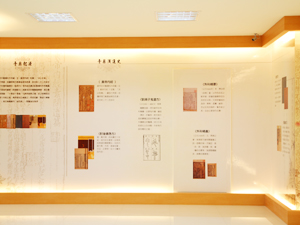|
|
|
|
 |
|
Experience the beautiful relationship that exists between science and Chinese medicine with your five senses!-
|
|
"With 46 years of medicine production experience, 3 years of preparation and a 1 billion NTD investment, the Chinese Medicine Museum was established as Taiwan’s first ever large-scale, comprehensive Chinese Medicine Museum."
|
|
|
“Chinese patent medicine” shares a close relationship with life. If you have ever visited a Chinese medicine clinic, it’s most likely that you have also used some of the medicinal powder prescribed by a Chinese medicine specialist – this powder is Chinese patent medicine.
The medicinal treatments used in Chinese medicine are unique to the East. With a history in China that extends back 5000 years, over the years the practices have become wide spread. Along with continuous developments in production technology, Chinese medicines have also taken on the new form of “Chinese patent medicine”, which is now the main type of modern treatment used by Chinese medicine clinics.
With 46 years of medicine production experience, 3 years of preparation and a 1 billion NTD investment, the Chinese Medicine Museum was established as Taiwan’s first ever large-scale, comprehensive Chinese Medicine Museum. The museum is situated in the world’s only “Agriculture and Biotechnology Park”, on a beautiful campus in Taiwan that was developed by the Executive Yuan with a 10 billion NTD investment. With a focus on agriculture and biotechnology, the science park is home to a beautiful ecological pond and vast green fields accented by a mountainous backdrop. While visiting the museum, don’t miss the ecological tour!
The museum displays the essence of 5000 years of traditional Chinese medicine together with the advancements of modern science. Divided into four main sections, including Chinese Patent Medicine, Antrodia camphorata (AC), Medicinal Wines and Traumatology, the museum displays a diverse selection of Chinese medicines and will provide you with an in-depth understanding of the mysteries that have developed into the modern-day practices of Chinese patent medicine.
|
 |
| The Chinese Patent Medicine Area has a comprehensive display of the beautiful integration of the 5000 years of wisdom and scientific techniques used in Chinese medicine. In essence, it provides an introduction of the elements and processes behind the production of Chinese patent medicine, using detailed explanations on everything from material selection, extraction, decoction and concentration, to dosage forms, quality inspections, types of dosage and applied development. Allowing visitors to get to know Chinese patent medicine and understand how to distinguish between different qualities --- providing you with a lovely relationship with Chinese patent medicine. |
|
|
 |
In the “Treatise on Food and Money” found in the Book of Han, the historian Ban Gu strongly emphasizes the great medicinal value of wine (alcohol), pointing out that wine plays an important role in treatment. According to the explanation of the Chinese character that signifies “medical” (醫), it is noted that the bottom half of the character includes a symbol (酉) which represents wine (酒). This is pointed to as evidence of the close relationship between alcohol and medicine.
Wine (alcohol) was acclaimed by Ban Gu to be the “greatest of medicines”. In the Medicinal Wine Area, the origins of medicinal wine serve as the primer, as visitors are provided with an in-depth understanding of the special importance that medicinal wine has in Chinese medicine. Explanations are provided on how the medicinal properties and effectiveness of the medicinal materials are heightened under the catalyst of the medicinal wine. Detailed introduction on the testing of the medicinal herbs, methods of concoction, usage and special properties of the medicinal wines are also provided. Additionally, visitors will learn about age-old and highly popular medicinal wines such as “CHOU KUNG PAI SUI MEDICATED WINE” and the “RU YI CHANG CHUN MEDICATED WINE”, with samples offered periodically provide the visitors a chance to smell the aroma and experience the pure quality and distinct flavour. |
|
 |
 |
The earliest external-use Chinese medicines for trauma care are recorded in the “Formulas for Universal Relief” section of the Esoteric Scripture of the Yellow Emperor, compiled during the Ming Dynasty by Su Zhu and others. The “Li Yue Pianwen - Rhymed Discourse for Topical Remedies” edited by Wu Shangxian of the Qing Dynasty is another literary contribution on the subject. There are many types of trauma medicines that have been used throughout history, with many different purposes. The most common of these are the herbal plaster (ointment) type, such as “Purple Cloud Ointment” and “Wann Ing Ointment”. Others types, including medicinal washes and patches, are also commonly used to treat wounds.
From the Esoteric Scripture of the Yellow Emperor to the Wu Shangxian’s Rhymed Discourse – the changes and applications of external use trauma medicines can be seen on display in the Traumatology Area, providing visitors with a glimpse into the trauma medications used throughout the history of Chinese medicine. Additionally, the museum presents several types of ointments, patches and medicinal washes in common use, with in-depth explanations of the medicinal effects, medicinal components and methods of use, so that guests can learn how to distinguish between the different qualities of medicines.
|
|
 |
|
|
|
|
|
|